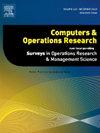灾后通信无人机基站位置和移动充电无人机路径优化
IF 4.3
2区 工程技术
Q2 COMPUTER SCIENCE, INTERDISCIPLINARY APPLICATIONS
引用次数: 0
摘要
在灾难发生后,传统的通信系统往往无法使用,给救援队和受影响的个人带来了巨大的挑战。本研究旨在设计一种创新的沟通系统来弥补这一差距,确保有效的信息传递,并在救援队和受灾群众之间建立可靠的沟通渠道。重点是使用无人机作为通信工具来应对这一挑战。该研究探索了在灾区使用无人机作为数据收集和传输平台。通过收集个人信息,包括来自不同平台的短信和位置数据,无人机可以有效地将重要数据传输到通信回程。建立了优化模型,以确定无人机基站的三维位置,同时最大限度地提高覆盖和服务质量。此外,还需要移动电源无人机为部署的基站供电和数据传输;该模型还决定了多个动力无人机的路由。为了有效地解决这一问题,提出了一种基于聚类的基站位置确定方法。我们在一个案例研究中展示了该模型的解决方案性能和我们的启发式算法的有效性,该案例研究使用了来自土耳其苏丹比利省的数据。启发式算法在不到一个小时的时间内解决了所有案例研究实例,其中包括700个节点,75-105架固定无人机和6-8架移动无人机。结果表明,105架固定无人机和8架移动无人机可以覆盖82%的用户。此外,我们还演示了如何通过实施某些调整将该覆盖率提高到95%。这些发现为在灾后场景中使用无人机基站的潜力提供了见解,从而增强了灾害管理机构的通信能力,从而改善了面对灾害时的协调和反应。本文章由计算机程序翻译,如有差异,请以英文原文为准。
Optimization of drone base station locations and mobile charging drone routing for post-disaster communication
In the aftermath of a disaster, traditional communication systems often become inaccessible, creating significant challenges for rescue teams and affected individuals. This research aims to design an innovative communication system to bridge this gap, ensuring efficient information transfer and establishing reliable communication channels between rescue teams and affected people. The focus is on using drones as communication tools to address this challenge. The study explores the use of drones as data collection and transmission platforms in disaster-stricken areas. By collecting information from individuals, including text messages and location data from different platforms, drones can efficiently transmit vital data to the communication backhaul. An optimization model is formulated to decide on the 3D location of drone base stations while maximizing coverage and service quality. In addition, mobile power drones are also required to supply the power for deployed base stations and data transfer; the model also decides on the routing of multiple power drones. To solve the problem efficiently, a clustering-based matheuristic is developed to determine the locations of the base stations. We show the solution performance of the model and the effectiveness of our heuristic algorithm in a case study using data from Sultanbeyli province in Türkiye. The heuristic algorithm solves all the case study instances, which consist of 700 nodes, 75–105 stationary drones, and 6–8 mobile drones, in less than an hour. The results show that with 105 stationary and 8 mobile drones, we can cover 82% of the users. Furthermore, we demonstrate how this coverage can be increased to 95% by implementing certain adjustments. The findings offer insights into the potential of using drone base stations in post-disaster scenarios, thereby empowering disaster management agencies with enhanced communication capabilities for improved coordination and response in the face of disaster.
求助全文
通过发布文献求助,成功后即可免费获取论文全文。
去求助
来源期刊

Computers & Operations Research
工程技术-工程:工业
CiteScore
8.60
自引率
8.70%
发文量
292
审稿时长
8.5 months
期刊介绍:
Operations research and computers meet in a large number of scientific fields, many of which are of vital current concern to our troubled society. These include, among others, ecology, transportation, safety, reliability, urban planning, economics, inventory control, investment strategy and logistics (including reverse logistics). Computers & Operations Research provides an international forum for the application of computers and operations research techniques to problems in these and related fields.
 求助内容:
求助内容: 应助结果提醒方式:
应助结果提醒方式:


